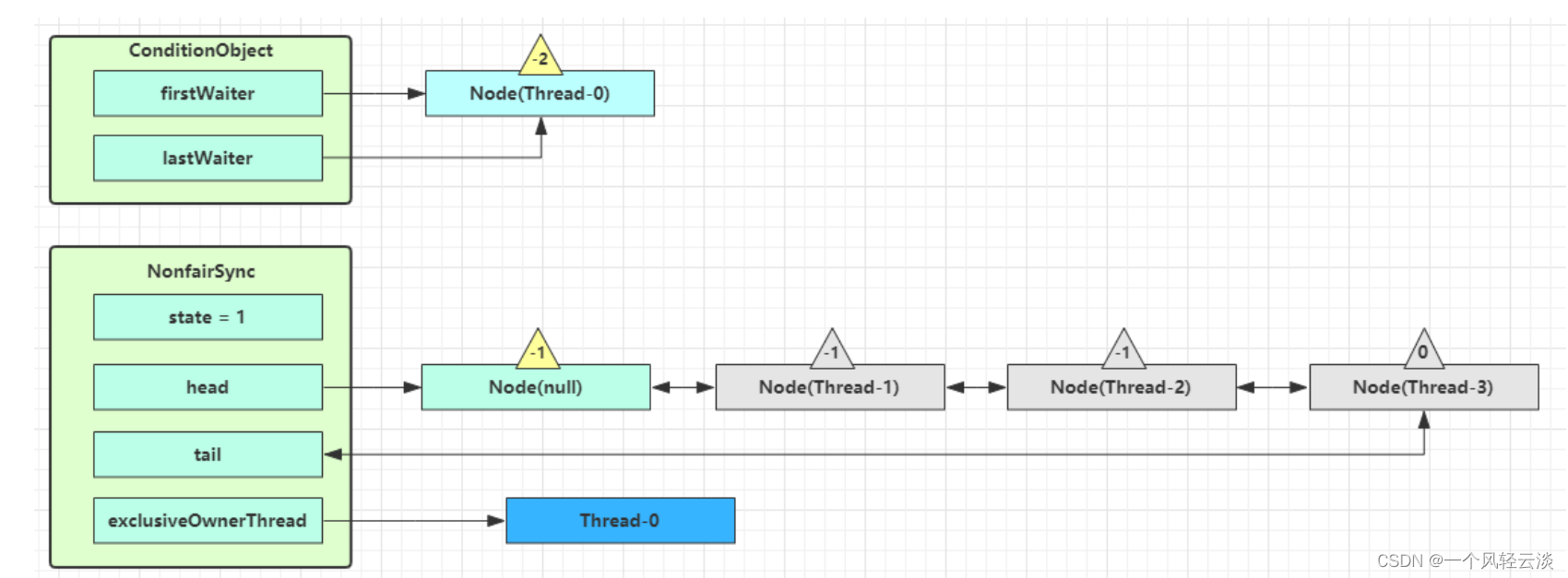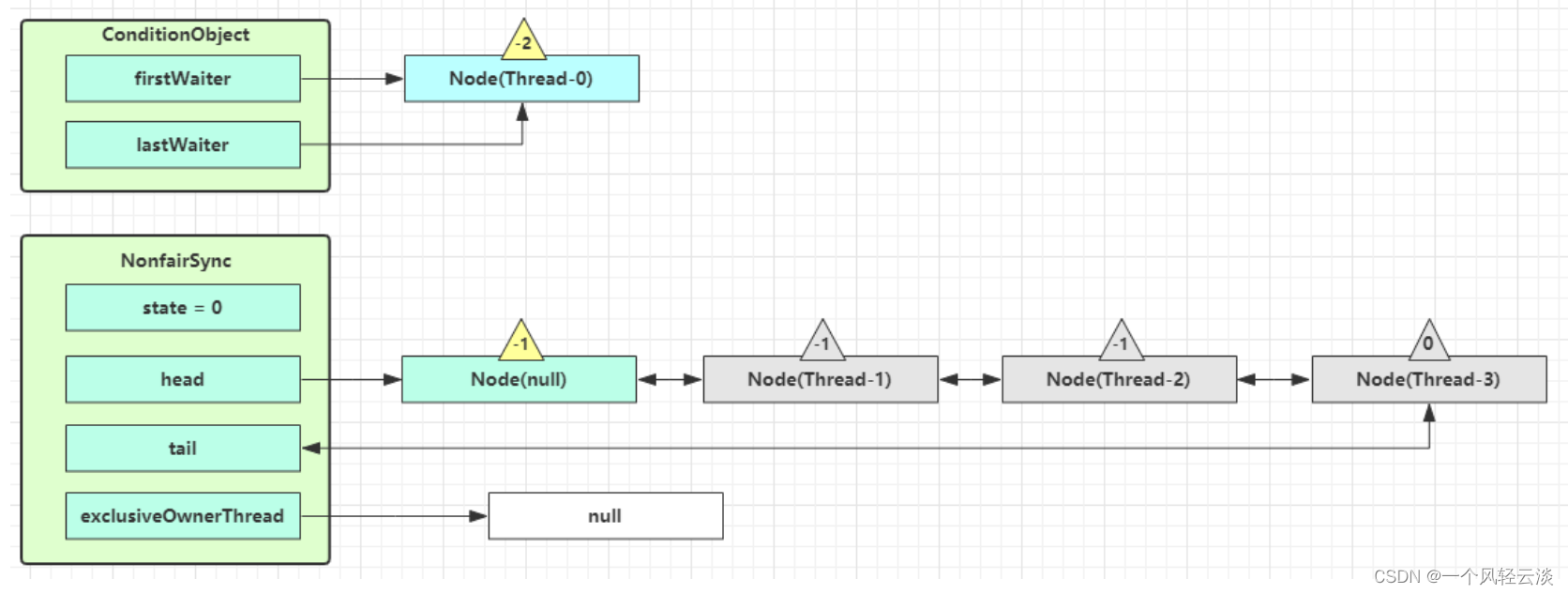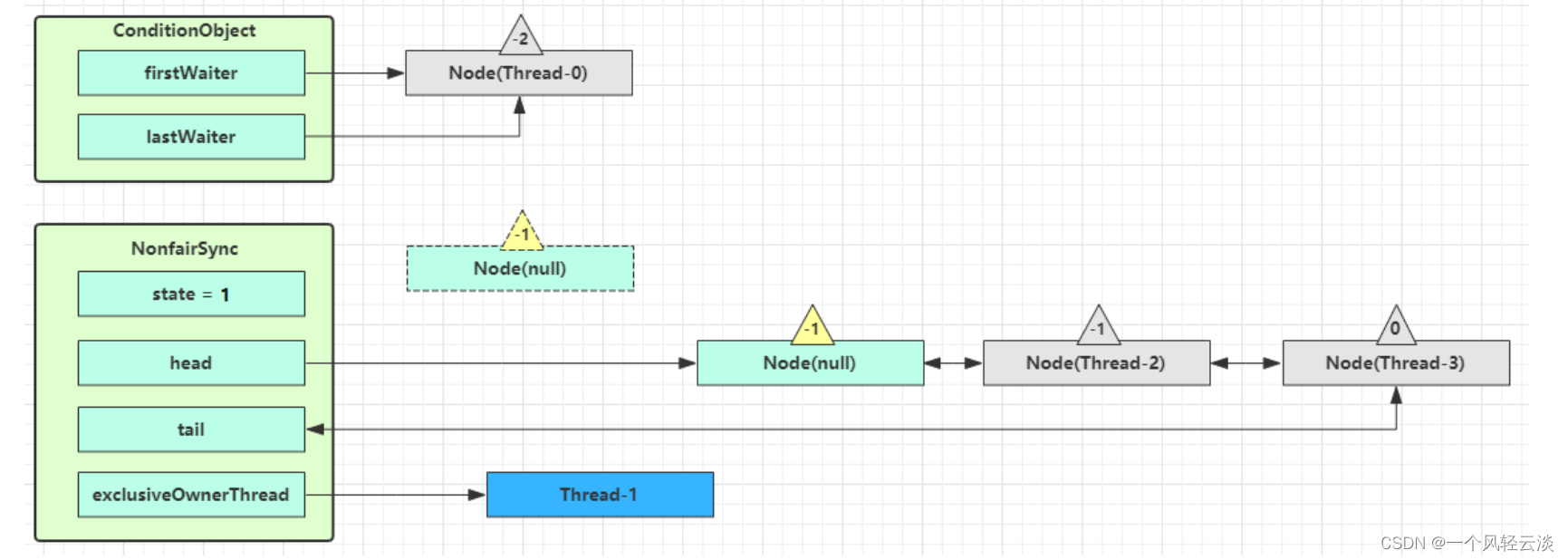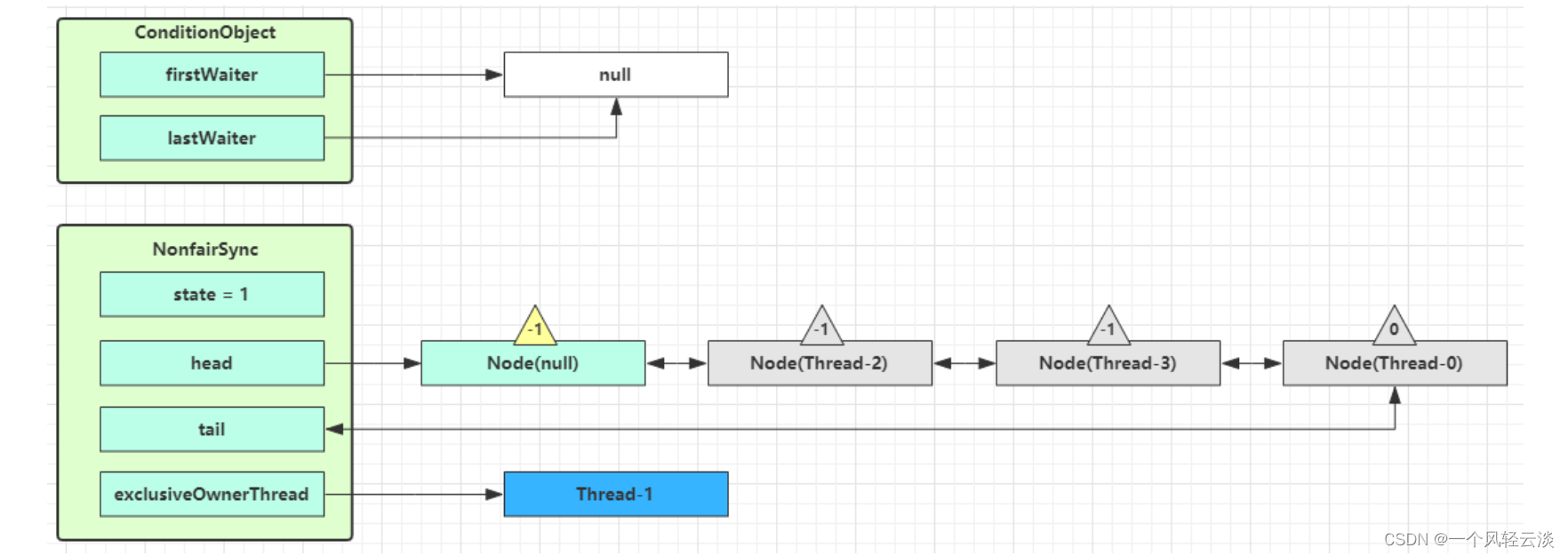目录
可重入原理
什么是可重入:当线程请求一个由其它线程持有的对象锁时,该线程会阻塞,而当线程请求由自己持有的对象锁时,如果该锁是重入锁,请求就会成功,否则阻塞。
重入锁实现可重入性原理或机制是:每一个锁关联一个线程持有者和计数器,当计数器为 0 时表示该锁没有被任何线程持有,那么任何线程都可能获得该锁而调用相应的方法;当某一线程请求成功后,JVM会记下锁的持有线程,并且将计数器置为 1;此时其它线程请求该锁,则必须等待;而该持有锁的线程如果再次请求这个锁,就可以再次拿到这个锁,同时计数器会递增;当线程退出同步代码块时,计数器会递减,如果计数器为 0,则释放该锁。具体源码如下
static final class NonfairSync extends Sync {
// ...
// Sync 继承过来的方法, 方便阅读, 放在此处
final boolean nonfairTryAcquire(int acquires) {
final Thread current = Thread.currentThread();
int c = getState();
if (c == 0) {
if (compareAndSetState(0, acquires)) {
setExclusiveOwnerThread(current);
return true;
}
}
// 如果已经获得了锁, 线程还是当前线程, 表示发生了锁重入
else if (current == getExclusiveOwnerThread()) {
// state++
int nextc = c + acquires;
if (nextc < 0) // overflow
throw new Error("Maximum lock count exceeded");
setState(nextc);
return true;
}
return false;
}
// Sync 继承过来的方法, 方便阅读, 放在此处
protected final boolean tryRelease(int releases) {
// state--
int c = getState() - releases;
if (Thread.currentThread() != getExclusiveOwnerThread())
throw new IllegalMonitorStateException();
boolean free = false;
// 支持锁重入, 只有 state 减为 0, 才释放成功
if (c == 0) {
free = true;
setExclusiveOwnerThread(null);
}
setState(c);
return free;
}
}
可打断原理
不可打断模式
在此模式下,即使它被打断,仍会驻留在 AQS 队列中,一直要等到获得锁后方能得知自己被打断了
// Sync 继承自 AQS
static final class NonfairSync extends Sync {
// ...
private final boolean parkAndCheckInterrupt() {
// 如果打断标记已经是 true, 则 park 会失效
LockSupport.park(this);
// interrupted 会清除打断标记
return Thread.interrupted();
}
final boolean acquireQueued(final Node node, int arg) {
boolean failed = true;
try {
boolean interrupted = false;
for (;;) {
final Node p = node.predecessor();
if (p == head && tryAcquire(arg)) {
setHead(node);
p.next = null;
failed = false;
// 还是需要获得锁后, 才能返回打断状态
return interrupted;
}
if (shouldParkAfterFailedAcquire(p, node) &&
parkAndCheckInterrupt()
) {
// 如果是因为 interrupt 被唤醒, 返回打断状态为 true
interrupted = true;
}
}
} finally {
if (failed)
cancelAcquire(node);
}
}
public final void acquire(int arg) {
if (!tryAcquire(arg) &&
acquireQueued(addWaiter(Node.EXCLUSIVE), arg)
) {
// 如果打断状态为 true
selfInterrupt();
}
}
static void selfInterrupt() {
// 重新产生一次中断
Thread.currentThread().interrupt();
}
}可打断模式
可打断:本线程在等待获得锁的过程中,别的线程可以中止我的等待;
ReentrantLock不可打断模式:即使被打断,仅仅是打断标识设置为true,但是仍然线程会在AQS队列中,获得锁之后能够继续执行;
ReentrantLock可打断模式:源码层面当unpark之后,直接进入异常,抛出,不会再进入死循环;
static final class NonfairSync extends Sync {
public final void acquireInterruptibly(int arg) throws InterruptedException {
if (Thread.interrupted())
throw new InterruptedException();
// 如果没有获得到锁, 进入 ㈠
if (!tryAcquire(arg))
doAcquireInterruptibly(arg);
}
// ㈠ 可打断的获取锁流程
private void doAcquireInterruptibly(int arg) throws InterruptedException {
final Node node = addWaiter(Node.EXCLUSIVE);
boolean failed = true;
try {
for (;;) {
final Node p = node.predecessor();
if (p == head && tryAcquire(arg)) {
setHead(node);
p.next = null; // help GC
failed = false;
return;
}
if (shouldParkAfterFailedAcquire(p, node) &&
parkAndCheckInterrupt()) {
// 在 park 过程中如果被 interrupt 会进入此
// 这时候抛出异常, 而不会再次进入 for (;;)
throw new InterruptedException();
}
}
} finally {
if (failed)
cancelAcquire(node);
}
}
}公平锁实现原理
线程在获取锁时以公平的形式进行,没有线程占用锁时可以直接获取锁成功,已经有线程占用锁或者已经有人在排队时将进入队列排队等待。公平锁不会出现饥饿效应,所有的线程都有可以获取到锁,但对CPU唤醒线程的开销较大,线程越多开销越大
static final class FairSync extends Sync {
private static final long serialVersionUID = -3000897897090466540L;
final void lock() {
acquire(1);
}
// AQS 继承过来的方法, 方便阅读, 放在此处
public final void acquire(int arg) {
if (!tryAcquire(arg) &&
acquireQueued(addWaiter(Node.EXCLUSIVE), arg)
) {
selfInterrupt();
}
}
// 与非公平锁主要区别在于 tryAcquire 方法的实现
protected final boolean tryAcquire(int acquires) {
final Thread current = Thread.currentThread();
int c = getState();
if (c == 0) {
// 先检查 AQS 队列中是否有前驱节点, 没有才去竞争
if (!hasQueuedPredecessors() &&
compareAndSetState(0, acquires)) {
setExclusiveOwnerThread(current);
return true;
}
}
else if (current == getExclusiveOwnerThread()) {
int nextc = c + acquires;
if (nextc < 0)
throw new Error("Maximum lock count exceeded");
setState(nextc);
return true;
}
return false;
}
// (一) AQS 继承过来的方法, 方便阅读, 放在此处
public final boolean hasQueuedPredecessors() {
Node t = tail;
Node h = head;
Node s;
// h != t 时表示队列中有 Node
return h != t && (
// (s = h.next) == null 表示队列中还有没有老二
(s = h.next) == null ||// 或者队列中老二线程不是此线程
s.thread != Thread.currentThread()
);
}
}
非公平锁原理:
成员变量 sync = new NonfairSync(默认);
加锁时:compareAndSetState,尝试改变状态,成功就把Owner设置为当前线程,失败就再tryAcquire一次,还是失败,就创建一个节点对象,把线程加到等待队列(双向链表)里面去,park住当前线程;
释放锁:两种情况,一是唤醒的时候没有加锁的来竞争,唤醒head的后继结点,unpark它,然后把head节点链接到next等待的线程;二是有加锁的来竞争并且竞争成功,owner是别人,自己继续阻塞park;
条件变量实现原理
每个条件变量其实就对应着一个等待队列,其实现类是 ConditionObject
每一个条件变量Condition都对应一个ConditionObject,含有firstWaite和lastWaiter指针。await:把线程加入到ConditionObject的链表中去,释放掉该线程所有的锁,把自己park住,然后唤醒下一个节点;
signal:必须要锁的持有者来调用该方法,把ConditionObject链表中的第一个线程转移到AQS的等待队列中;
await 流程
- 开始 Thread-0 持有锁,调用 await,进入 ConditionObject 的 addConditionWaiter 流程
- 创建新的 Node 状态为 -2(Node.CONDITION),关联 Thread-0,加入等待队列尾部

接下来进入 AQS 的 fullyRelease 流程,释放同步器上的锁

unpark AQS 队列中的下一个节点,竞争锁,假设没有其他竞争线程,那么 Thread-1 竞争成功

park 阻塞 Thread-0

signal 流程
假设 Thread-1 要来唤醒 Thread-0

进入 ConditionObject 的 doSignal 流程,取得等待队列中第一个 Node,即 Thread-0 所在 Node

执行 transferForSignal 流程,将该 Node 加入 AQS 队列尾部,将 Thread-0 的 waitStatus 改为 0,Thread-3 的waitStatus 改为 -1

Thread-1 释放锁,进入 unlock 流程,略
























 394
394











 被折叠的 条评论
为什么被折叠?
被折叠的 条评论
为什么被折叠?










